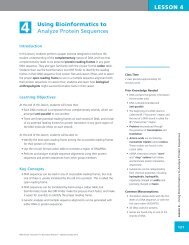WET LAB DNA Barcoding: From Samples to Sequences - Northwest ...
WET LAB DNA Barcoding: From Samples to Sequences - Northwest ...
WET LAB DNA Barcoding: From Samples to Sequences - Northwest ...
You also want an ePaper? Increase the reach of your titles
YUMPU automatically turns print PDFs into web optimized ePapers that Google loves.
<strong>WET</strong> <strong>LAB</strong><br />
KEY<br />
Lab 1: <strong>DNA</strong> Purification for<br />
<strong>DNA</strong> <strong>Barcoding</strong> Teacher Answer Key<br />
1. On a separate sheet of paper or in your lab notebook, describe what happened <strong>to</strong> the cell membrane.<br />
Where did it go?<br />
The cell membrane was digested or broken down by the detergents in the lysis solution. Pieces of the<br />
membrane are floating around in the buffer in the microfuge tube with the <strong>DNA</strong>.<br />
2. On a separate sheet of paper or in your lab notebook, describe what your sample looks like.<br />
If students began with a sample of the appropriate size (i.e., not <strong>to</strong>o big), the cells should be completely lysed,<br />
and the samples should be clear, indicating that all of the membranes have been dissolved.<br />
3. What did you do in this labora<strong>to</strong>ry experiment and why?<br />
Students purified <strong>DNA</strong> from sample X <strong>to</strong> perform <strong>DNA</strong> barcoding. Students may go in<strong>to</strong> greater detail<br />
about the specific steps of the pro<strong>to</strong>col: breaking open the cells, dissolving the membranes, and<br />
removing the <strong>DNA</strong> from the rest of the cell debris. The important thing is for students <strong>to</strong> understand<br />
that genetic research starts with <strong>DNA</strong>, and we must have <strong>DNA</strong> purified away from the other cellular<br />
components for subsequent experiments.<br />
4. What skills did you learn or practice?<br />
This question is designed <strong>to</strong> help students identify labora<strong>to</strong>ry skills that they can list on a resume and/or<br />
college application.<br />
• Handling samples<br />
• Pipetting<br />
• Microcentrifugation<br />
• <strong>DNA</strong> purification using spin columns<br />
5. List at least three types of samples from which you could purify <strong>DNA</strong>, based on what you have learned about<br />
tissues in your classes. What type of cells or tissues could you not purify <strong>DNA</strong> from?<br />
This question is designed <strong>to</strong> help students realize that <strong>DNA</strong> is present in, and can be isolated from, many<br />
different types of cells/tissues. Common samples include:<br />
• Muscle<br />
• Blood<br />
• Saliva<br />
• Shaft of bird feathers (analogous <strong>to</strong> the root of a mammalian hair)<br />
Wet Lab – <strong>DNA</strong> <strong>Barcoding</strong>: <strong>From</strong> <strong>Samples</strong> <strong>to</strong> <strong>Sequences</strong><br />
367<br />
©<strong>Northwest</strong> Association for Biomedical Research—Updated Oc<strong>to</strong>ber 2012
















